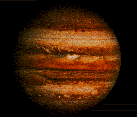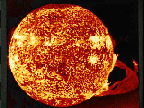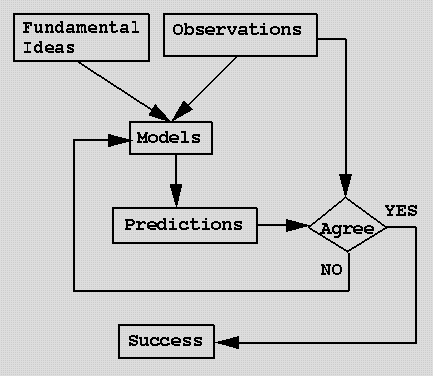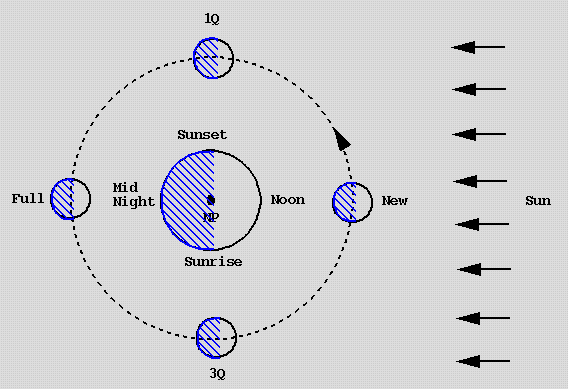ISP 205, Section 3 Hufnagel & Stein
UNIT I: THE SKY
OUTLINE
-
 Introduction: Tour of the
Universe
Introduction: Tour of the
Universe
 A. Scientific Models or Theories
A. Scientific Models or Theories
 B. Appearance of the sky
B. Appearance of the sky
 C. Models of the Solar System
C. Models of the Solar System
 D. Motion and Gravity
D. Motion and Gravity
Reading: Chapter 1
(The numbers refer to AST laserdisk frames.)
- Planets: AST disk: Earth: 11128, 11173; Moon: 11603; Mercury: 10511;
Venus: 10778; Mars: 11803, 11806; Jupiter: 12933; Io: 12949;
Saturn: 13256.
 Jupiter
Jupiter
 Pluto and Charon
Pluto and Charon
- Sun. white light; 10426; Halpha; 1843; X-Ray: 10435
 The Sun in Halpha
The Sun in Halpha
- Stars. Asterism - Big Dipper: 9491; Clusters - Orion: 7702: 1822: pleiades: 2785
- Galaxies: Milky Way look-alikes. Andromeda (top-view): 717; NGC 4565 (side-view): 721
 Andromeda Galaxy (M31)
Andromeda Galaxy (M31)
- Clusters of galaxies. Leo: 693; Virgo: 694; Coma: 8333; Pisces: 699
Scale of astronomical objects
- If the Sun is a grape, the nearest star is 100 mi away
- If the Earth is a tennis ball, then the Moon is a ping pong ball
7 feet away.
[Movie: Universe, 30 min.]
Reading: Chapter 2 (sections 2.2, 2.3)
Model or Theory is a picture in your mind of reality
- Goal:
- Simplest rule to explain most phenomena
- Scientific Models (Theories, Laws):
- Isolate relevant experience from distracting or trivial effects
- Discern a stable relationship in the flux of events
- Express the relationship mathematically.
- Process of model building:
(similar to everyday problem solving)
- 1. Problem
- Observations to explain or conflict between observations
and existing model
- Define what problem is. Ask the right questions.
- 2. Generate a New Model/Theory
- Use divergent, flexible thinking; brainstorming.
- More than one possible solution, weigh pros and cons.
- Usually modify old model, occasionally something entirely
different.
- based on fundamental ideas, previous theories, aesthetics
and solution to problem
- 3. Test Model/Theory
- Make Predictions
- Compare predictions of model with new observations.
- How well does model correspond to reality?
- Revise model/theory if necessary (-> step 1).

- [video: magic hut (start 3m54s)(20 min)]
- Criteria for Fruitful, Successful Model
- Relate many observations. Simple, easy to grasp. Few assumptions.
- Makes predictions that agree with experience.
- Solves significant problems.
- Stimulates new investigations.
- Limitations
Models are based on limited experience.
They are extrapolated to a range of similar situations and are
applied in a broader context than that in which they were developed.
Sooner or later, enough contradictory observations exist that the
assumptions are no longer valid.
Theories are seen to be too limited or too inaccurate.
Examples:
- sunspots vs. Republicans in Senate (extrapolation)
- sunspots vs. rainfall (limited observations)
- height vs. age (biased observations)
- Proof
Can disprove a theory by failure to correctly predict phenomena.
Cannot prove a theory correct.
Scientists know that none of the theories and models we use are perfect:
-
-
The criterion for a good model is its usefulness for the task for
which it is used.
Can increase our confidence in it by successes in predicting phenomena.
Activity: surviving in the wilderness
Reading: Chapter 4
- Model of Sky -- Celestial Sphere
Reading: sections 4.3, 4.4
- Problem: location of stars, motion of planets, what holds stars up
- Model: Celestial Sphere
- ancient - stars on crystal sphere
- modern - globe surrounding Earth
- Celestial Equator - over Earth's equator,
= projection of Earth's equator
- Celestial N & S Poles - over Earth's poles,
= projection of Earth's poles
- zenith - point directly overhead
- meridian - line from north celestial pole through zenith to
south point on horizon.
- [AST disk, celestial equator 9998, Earth 10002, meridian 10003-4]
- Use: Coordinate system
- Declination - angle N or S or celestial equator (like latitude),
measured in degrees
- Right Ascension - East-West position on celestial sphere
(like longitude). Measured eastward from position where sun
crosses celestial equator in spring (vernal equinox),
in units of hours:minutes:seconds.
- [AST disk: 9983(?), 9995-10000]
- [demo: celestial globe]
- Twelve Constellations in the Zodiac.
- Pisces (S of Pegasus, see in fall) (RA 0 h)
- Gemini (near Orion, see in winter) (RA 6 h)
- Virgo (near Leo, see in spring) (RA 12 h)
- Sagittarius (S of Vega, see in summer) (RA 18 h)
Sept. Sky Map from Abrams Planetarium
- Limitations:
- All models have limitations.
- Need different models for different purposes.
- Limitation of Celestial Sphere Model:
Third dimension - distance.
- The Sun
Reading: sections 4.4, 4.5
- (i) Daily Motion, due to Rotation of Earth toward the East
on its axis
- E->W re. horizon
- Time: day determined by rotation of Earth.
- [star trails, AST disk 9931, 10070-71]
- [Rotating telescope represents Earth, AST disk, step 10090-10105,
slow play 10106-10166]
- Demo: spotlight and globe
- [Rotating Earth from geosynchronus orbit, AST disk,
step 11155-11188]
- demo: voyager
- (ii) Annual Motion, due to orbit of Earth toward East about Sun
- W->E re stars.
- Path of sun in sky = ECLIPTIC
- Seasons: Due to inclination of Earth's axis of rotation
with respect to plane of its orbit around sun
- Year determined by motion of Earth around sun.
- Winter Solstice - about Dec 21. Sun farthest south,
rises SE, sets SW. Long night, short day.
- Vernal (spring) Equinox - about March 21.
Sun rises E, sets W. Equal day and night.
- Summer Solstice - about June 21. Sun farthest north,
rises NE, sets NW. Long day, short night.
- Autumnal Equinox - about Sept 21.
Sun rises E, sets W. Equal day and night.
- Demo: Motion re stars, spotlight and globe (move Sun then Earth,
eg geo vs helio centric)
- Demo: light on liquid crystal, dependence of heating on inclination.
- [Height of Sun, AST disk 10180-10224]
- [slide sequence: sunrise Jan-June]
- [Inclination, AST disk 9921,9923-24(solar rays)]
- [AST disk 10168-79]
- Demo: voyager
- Stars
Reading: sections 4.3, 4.6, 4.9, 4.10, Appendix chapter 4
(i) Recognize Bright stars and their constellations.
Locate on star map and in sky.
16 Brightest Northern Hemisphere Stars
Map of Taurus
(ii) See different stars at different seasons,
because of Earth's orbit about the Sun.
Night side of Earth faces in different directions.
Planetarium, star maps
- Moon
Reading: sections 3.1-3.3, 4.7
- Daily Motion
- Monthly motion: due to orbit of Moon toward East about Earth
- Time: month determined by motion of moon around Earth.
- (i) Phases
- Illuminated side faces sun. View it from Earth,
see different fraction of illuminated side depending on
position in orbit.
- Times of rising and setting at different phases.
- [Earth, Moon, Sun diagram, AST disk 9940, phases 9941-9949]
- Activity: spotlight, tennis and Ping-Pong balls

- (ii) Eclipses
- Solar - moon between sun and Earth, casts shadow on Earth
- Lunar - Earth between sun and moon, casts shadow on moon
- Moons orbit tilted 5o from the ecliptic.
Twice a year point where
moons orbit crosses ecliptic located on line between
sun and Earth, so sun, moon and Earth can lie on straight line
- [Video: July 91 eclipse.]
- [Solar, AST disk 9965-71]
- [Lunar, AST disk 9958, 9960-64]
- [Earth, Moon, Sun diagram, AST disk 9957]
- Activity: spotlight, balls
- the Planets
Reading: section 4.8
- Daily motion - East with respect to the horizon
- Annual motion - generally East with respect to the stars,
near the ecliptic.
- Retrograde motion - part of each year moves West with
respect to the stars
- [retrograde motion Mars: AST disk 9904, slow play 10277-10288]
- Demo: voyager
- Planetarium
-
- Venus & Mercury - always near Sun
- Mars, Jupiter and Saturn - anywhere along ecliptic
- Brightness not uniform - constantly changing
- Motion not uniform - faster and slower compared to the stars
- Planetarium
- Orientation: N,S,E,W
- planetarium, streets, equator, poles
- Motion of planets re stars,
- direct and retrograde motion
- Geocentric & Heliocentric views - Orrery
- [Activity: path of Mars re stars]
- Daily Motion
- Annual Motion (Stars, Sun)
- Moon
- Bright Stars and Constellations
- Coordinates
- [Activity: identifying stars on map, locate Moon]
Reading: chapter 5
- Ptolemaic Model
Reading: sections 5.1, 5.2
- Observations: daily and annual motions of the Sun, Moon, and planets.
Eclipses. No stellar parallax.
- Fundamental ideas: Heavens are perfect. Perfect geometry is circle
and spheres.
- Problem: predict planetary positions and motion
- Model: Geocentric. - Sun, Moon and all planets move around
the Earth on circles.
-
- Natural motion of heavenly bodies is Uniform Circular Motion
- Observed motions can't be explained by simple geocentric model,
need complex model of epicycles, eccentric and deferent
- Deferent - Daily motion E-> W, and Motion W-> E re stars
- all heavenly objects whirl around Earth E->W daily.
- Planets move slower along deferent than stars
- Epicycles - Retrograde motion
- Planet moves around epicycle, center of epicycle moves along
deferent.
- When planet is moving backwards along inner part of
epicycle ->retrograde motion
- Venus and Mercury
- Centers of epicycles lie on Earth-sun line.
- Size of epicycles determined by greatest distance from sun.
- Mars, Jupiter and Saturn
- Radius of epicycles align with Earth-sun radius in order to
make retrograde motion occur when planet opposite the sun,
but anywhere on deferent.
- Size of epicycle determined by size of retrograde loop.
Decreases from mars -> Jupiter -> Saturn.
- Eccentric - Non-uniform motion
- Earth offset from center of deferent circle.
- Planets appear to move faster when closer to Earth, slower
when farther away
- Equant - non-uniform motion
- motion along deferent not uniform. Appears uniform when
viewed from point offset from center of deferent opposite to
eccentric
- [Diagram, AST disk 6979, detail 6980, book plate 9906,
diagram 9907]
- [Geocentric view, AST disk, side 2, chapt 32]
- [Deferents & epicycles, Mechanical Universe prog 9, chapt 18,
Almagest chapt 19]
- [Ptolemaic and Tychonian models, Mechanical Universe,
prog 21, chapt 8 (15131)]
- Tests:
- Predicted planetary positions and motions.
Accurate to a few moon diameters. Tycho Brahe upset that
predicted conjunction of Jupiter & Saturn off by a month.
- No observable parallax. Earth doesn't appear to move.
- The geocentric model explains all the basic motions and observations
made with the naked eye.
- Copernican Model (1473-1543)
Reading: sections 5.3, 5.6, 5.7
[Portrait, AST disk 6995,6]
- Observations: Same as before: daily and annual motions of the Sun,
Moon, and planets. Eclipses. No stellar parallax.
- Fundamental ideas: Sun is at center. Perfect geometry of circles
and spheres.
- Problem:
- Aesthetics - Ptolemy did not use uniform circular motion (equant)
- Model: Heliocentric - all planets, including Earth,
orbit the sun.
- Planets closer to sun move faster
- Retrograde motion: faster moving inner planet overtakes
and passes slower moving outer planet.
- [AST disk, diagrams 9912,13, model 6997, book 6998]
- [Geocentric view, AST disk, side 2, chapt 33]
- [Copernican model, Mechanical Universe, prog 21,
chapt 9-10 (17000, 17141-17190)]
- Tests:
- Accuracy of predicted planetary positions unchanged.
- Problems:
- Why do objects fall straight down on spinning Earth?
- How are atmosphere and moon carried along by moving Earth?
- Galileo observed moons of Jupiter carried along with Jupiter
- No parallax (stars very distant, parallax very small, first
observed by Bessel in 1838)
- [AST disk 7032].
- Video: Mechanical Universe, program 4, chapter 19 (How things fall)
- [parallax, AST disk: 9918]
- Violent arguments
- Appeal -
- Aesthetic: Simple natural explanation of retrograde motion
- inner planets move faster, so overtake outer planets.
Explains why always at opposition.
Symmetry of nested orbits.
- More universal, Earth like other planets.
- Repugnance -
- Earth not unique
- Resolution - New Observations
- Phases of Venus -> Venus orbits sun (Galileo, 1565-1642)
[portrait, AST disk 7025,6] [Robbins et al. Fig 5-19.]
- Sunspots, moon mountains -> heavens not perfect
- Tycho Brahe (1546-1601) observed new bright star in
Cassiopeia (supernova).
Showed no parallax -> so farther than moon -> star ->
stars change;
- Observed comet, showed crossed orbits of Jupiter and Mars,
so no crystal spheres.
- [Portrait, AST disk 7004,5, observatory 7008, instruments 7012,
slides of Hven]
- Stellar parallax observed 1838 (Friedrich Bessel 1784-1846)
- Philosophy -
Earth not unique! Revolutionary! (Origin of meaning of word is
name of Copernicus book, "On the Revolutions of the Heavenly Spheres")
- Keplerian Model (1571-1630)
Reading: section 5.4
[portrait, AST disk 7019,20]
- Observations: Tycho Brahe's observations of Mars and other planets
- Problem:
- Observations of planetary positions by
Tycho Brahe (1546-1601) much more accurate ( ~1/8 moon diameter).
Inconsistent with Copernican model.
- [conflict observations and models,
Mechanical Universe, prog 21, chapt 2 (4500)]
- Model:
- a. Elliptical planetary orbits
- b. Non-uniform speed around orbit
- c. P2(yr) = a3(au),
planet's period is related to its distance from sun
- [ellipses, Mechanical Universe, prog 21, chapt 3-4]
- [diagram, AST disk, 9914,5]
- [3 laws, Mechanical Universe, prog 8 22, 25 (3 laws)]
- [Mechanical Universe, prog 21, chapt 12 (Earth's orbit),
13,14 (Mar's orbit)]
- Tests:
- Derived for Mars, test with other planets and comets.
- Much more accurate predictions of planetary positions.
- Philosophy:
- Non-uniform planetary motion. Not natural motion. Need a force.
- Appeal:
- Accuracy.
- Universality - all orbiting bodies (planets and satellites)
have same properties.
- Comparative Summary of Solar System Models
Reading: section 5.5
Ptolemy, Copernicus and Kepler's models were descriptive and geometric.
They did not explain. Newton developed an explanation.
[Newton portrait, AST disk 7034]
- Newton's Law of Motion (1642-1727)
- Motion only with respect to something
- Velocity
- Speed=distance traveled in given time
- Velocity=speed in given direction=distance traveled in given
direction in given time
- distance = velocity x time (e.g. mi/hr x hr = mi)
- Acceleration=change in velocity in given time
- speed up, slow down, turn
- Acceleration is intrinsic, need refer to nothing else.
- [Inclined planes, Mechanical Universe, program 4, chapt 25-26]
Newton's Law of Motion
acceleration = force / mass
-
- Force = push or pull
- Mass = inertia, resistance to change of motion.
Depends on amount of matter, not size.
- Examples: cars, balls, rockets
- Demo: pucks on air table
- Demo: pull cart with weights using spring
- Orbital Motion: direction changes (speed also changes slightly)
-> need force!
- [velocity, acceleration and force, Mechanical Universe, program 6,
chapt 13 (good animation)]
- Example: cars turning corners
- Newton's Theory of Gravity
Planet's motion in its orbit is accelerated (direction and magnitude of
velocity changes). Force is needed. Newton said force is gravity:
- Source of Gravitational Force is Mass.
- Every object attracts every other object by force of gravity.
- More Mass -> stronger gravity.
- Larger Distance -> weaker gravity.
Fgravity = G M m / D2
-
- [AST disk: F toward center 7087, F on planet 7088]
- [Mechanical Universe, program 8, chapt 28-29 (force of gravity)
- Show: Ratios and Exponents
- Interactive Physics II (PC): falling, orbiting bodies
with Motion Activity
- Tests
- Acceleration of Moon.
(Know acceleration = F/m at Earth's surface,
Know distance to Moon, Calculated acceleration at Moon's distance,
Compare actual acceleration found from period and distance)
[Mechanical Universe, program 8, chapt 38-43,
Newton's prediction 40; Moon's acceleration
41-42; circular motion, a=v2/r, prog 9 chapt 21-26]
- Solved problems of Copernican system: objects fall straight down,
atmosphere stays with planet, moon stays with planet
[Mechanical Universe, prog 4, chapt 34-36, (falling ball)]
- Orbits of comets, spacecraft, Neptune and Uranus.
(Laplace 1800 calculated Uranus orbit)
- Derivation of Kepler's laws. Used to determine masses.
- Discrepancy: Mercury, high speeds
- Philosophy:
- Mechanical Universe.
- Given knowledge of where everything is and how it is moving
now, and enough computer power, you can calculate everything
that will happen in the future.
- Appeal:
- Universal -- all motion, terrestrial as well as celestial
- Accurate predictions.
- Aesthetic -- simple, few assumptions
- Application: Determining masses
- Can only determine masses of astronomical bodies where
there are at least two bodies orbiting around each other.
- Can measure line of sight velocity by Doppler shift
- Can measure period
- Derivation of Kepler's Third Law (optional)
- Start with Newton's equations of motion and gravity
- a = F/m and Fgravity = GMm/D2
- Substitute Fgravity for the force in the
equation of motion.
- a = GMm/D2 * 1/m = GM/D2
- (Note: acceleration independent of mass of accelerated body)
- a = change in velocity / time = v/t
- v = distance / time = D/t
- a = D/t2
- D/t2 = GM/D2
- Solve for M: multiply by D2 and divide by G
- M = D3/Gt2 (Kepler's Third Law)
- Kepler's Third Law in Solar System Units
- is
- M1 [Msun]
+ M2 [Msun]
= D[AU]3 / P[yr]2
- where
- M1 = mass of body 1, in units of mass of Sun
- M2 = mass of body 2, in units of mass of Sun
- D = radius of nearly circular orbit (= semi-major axis
of ellipse in general) in AU (Astronomical Units)
- P = period of orbit in years
- Must convert distances to AU
- Must convert times to years
- If given other information must determine Distance and Period
- e.g. d=vt, t=d/v, where here distance = circumference of
orbit not its radius.
- If one mass is much less than the other, it can be
neglected.
- Work problem in class.
Reading: p 87, sec 15.5, p 439
- Energy
Reading: page 107 (section 6.5)
-
- Energy = ability to do work
- Kinetic energy = energy of motion
- Potential energy = work a force could do
- Energy is conserved:
Kinetic Energy + Potential Energy =Total Energy = constant
1/2 m v2 - GMm/D = E = constant
- ETotal = 0 at infinit separation. As fall the
KE increases (speeds up), so the PE must decrease (become
more negative) to keep the total energy = 0 (constant).
- Demo: pendulum
- If Energy is conserved, how do things get started,
or once moving how do they step? Work transfers energy.
- [Video: Ring of Truth: Change 2297-3412 (Toure de France,
energy conservation)]
- Applications:
- Do work to change speed, not to turn
- Bound orbit: total energy < 0.
- Unbound orbit: total energy > 0.
- Escape velocity: speed required to escape to infinity.
- Einstein's Theory of Motion and Gravity (Optional)
Reading: section 19.4
- Problem:
- Speed of Light the same for all observers.
- orbit of Mercury: axis precesses
- All objects fall at same speed: inertial mass = gravitational mass
-
- Demo: air track
- Video: Mechanical Universe, program 25, chapter 25-27
- New Model:
- Laws of Physics the Same for all freely moving observers.
- Speed of Light the Same for all observers.
- Can Not Distinguish between Gravity and Constant Acceleration
by some other force.
- Predictions:
- Light is attracted by gravity: Bending of Light by the Sun
Video: Mechanical Universe, program 25, chapter 29
- Energy = Mass (E=mc2):
move faster -> more energy -> more mass
-
- -> more inertia, can't exceed the speed of light
- Time dilation -- time slows down when moving
- Gravity is Geometry: Mass warps space-time. Warped space-time
controls how objects move.
- Tests:
- Orbit of Mercury, lifetimes of cyclotron particles,
displacement of stars close to Sun,
increase of inertia as speed increases.
Links to other resources on the Sky
-
 Abrams Planetarium
Abrams Planetarium
 Knowing the Sky (UCSD)
Knowing the Sky (UCSD)
 The Constellations and their Stars (UWisc)
The Constellations and their Stars (UWisc)
 The 26 Brightest Stars (UWisc)
The 26 Brightest Stars (UWisc)
 Purchasing Amateur Telescopes FAQ (NWestern)
Purchasing Amateur Telescopes FAQ (NWestern)
This page has been accessed
times.
Updated: 1997.03.31 (Monday) 09:19:32 EST
 Visions of the Universe
Visions of the Universe
Beth Hufnagel's home page, email:
bhufnage4@pilot.msu.edu
Bob Stein's home page, email:
steinr@pilot.msu.edu
 Introduction: Tour of the
Universe
Introduction: Tour of the
Universe
 A. Scientific Models or Theories
A. Scientific Models or Theories
 B. Appearance of the sky
B. Appearance of the sky
 C. Models of the Solar System
C. Models of the Solar System
 D. Motion and Gravity
D. Motion and Gravity
 Andromeda Galaxy (M31)
Andromeda Galaxy (M31)


![]() Visions of the Universe
Visions of the Universe